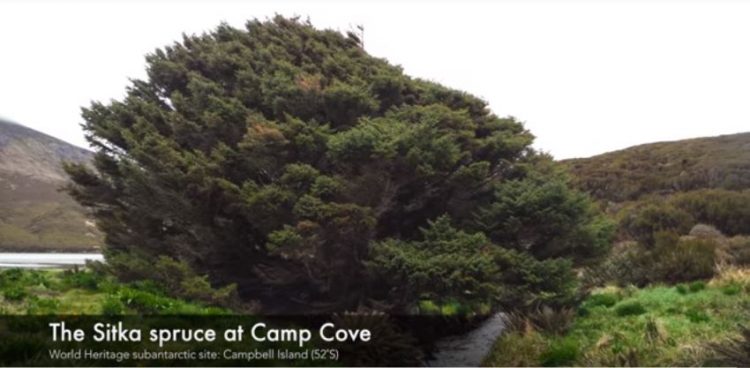According to the Guinness Book of World Records, a Sitka Spruce growing on New Zealand’s southernmost subarctic island, is the loneliest and most remote tree on Earth. Not only is it the only tree on Campbell Island, but the nearest other tree can be found over 200 kilometers away, on the Auckland Islands.
Located about 700 km south of Bluff, Campbell Island is one of the harshest places in the world. With strong winds blowing almost all year round, less than 600 hours of sunshine and only 40 days per year without rain, it’s not exactly an ideal place to live, which is probably why, except for occasional visits by research scientists, it has remained deserted for over half a century. Trees aren’t supposed to be growing here either, a fact made evident by the wind-tolerant shrubs and grasses covering the island, which only makes the thriving “loneliest tree on Earth” so much more impressive.

Photo: YouTube screengrab
It is believed that the Sitka Spruce thriving on Campbell Island was planted by the eccentric Lord Ranfurly, a former governor of New Zealand, sometime between 1901 and 1907. It’s not clear why he decided to plant here of all places, but according to some sources, he lamented that the island was not in productive use, and took the first step to cover it in productive forestry. His idea was never going to work due to the harsh climate of the area, but somehow the Sitka Spruce not only survived for more than a century, but actually thrived.
Apart from its reputation as the loneliest tree on Earth, the Sitka Spruce of Campbell Island has a series of other particularities. First of all its shape makes it look more like a giant cauliflower than a tree. This is believed to have been caused by the repeated chopping of its trunk every year, for decades.
You see, before 1958, when the remote meteorologic station on Campbell Island became fully automated, the staff stationed here would cut the top of the Sitka Spruce every Christams and haul it back to the station to use as a Christmas tree. But it somehow survived this yearly maiming, adapting its shape in the process. Luckily, no one has been cutting the tree down over the last six decades and it has grown to a height of over 10 meters.
Another fascinating thing about the world’s loneliest tree is that, despite being over 100 years old, it has never produced cones, which scientists claim suggests the tree has remained in a permanently juvenile state.
The Sitka Spruce of Campbell Island was recently in the news for helping researchers confirm that the Earth has entered an entirely new geological epoch, the Anthropocene. They found a radiocarbon spike, also known as a “golden spike”, in a sample collected from the core of the tree, which they say confirms our world has entered a whole new epoch.
Who knew a lonely tree growing 200 km away from its nearest cousins could be so interesting?
Sources: Noted, Radio NZ, Sub-Antarctic Stories, Phys.org






